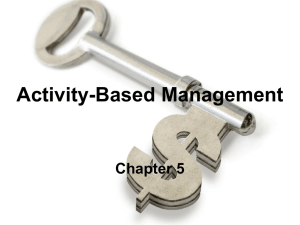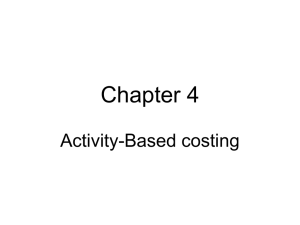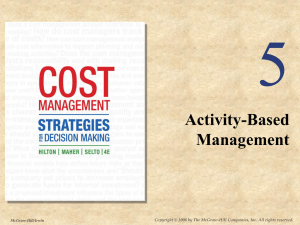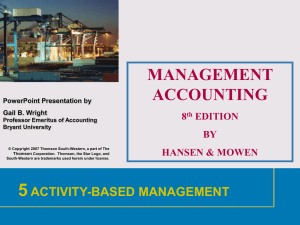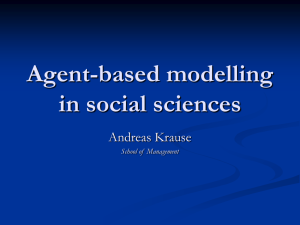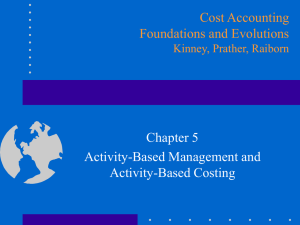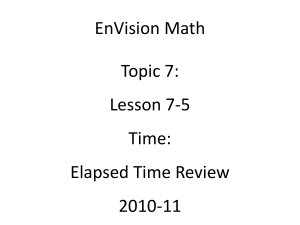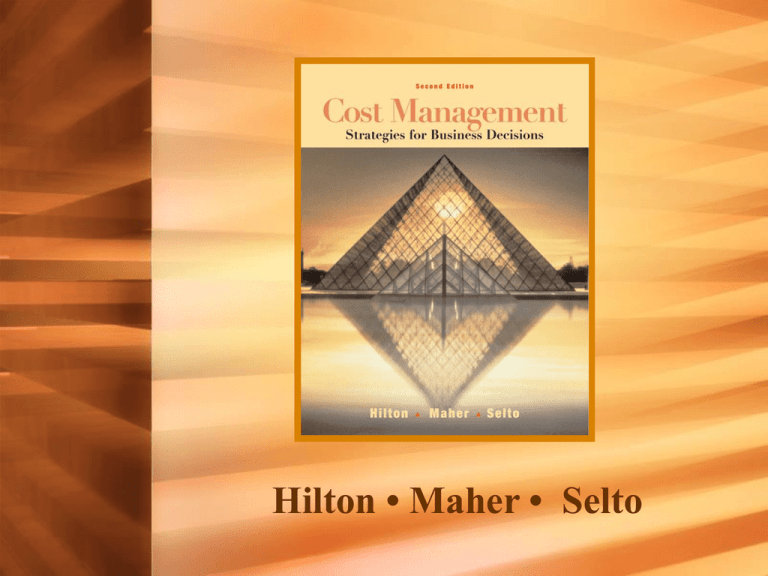
Hilton • Maher • Selto
Activity-Based Management
McGraw-Hill/Irwin
© 2003 The McGraw-Hill Companies, Inc., All Rights Reserved.
5-3
Activity-Based Management
(ABM)
Evaluates the
costs and values
of process
activities . . .
Activity-Based
Costing
+
. . . To identify
opportunities to
improve
efficiency.
Valued-Added
Analysis
=
Process
Improvements,
Customer Value, &
Reduced Costs
5-4
Activity-Based Management
ABM adds:
4 Basic Steps
Identify & classify the
activities related to the
company’s products or
services.
Estimate the costs
associated with each
activity.
Calculate a cost-driver rate
for each activity.
Assign activity costs to
products using the costdriver rate.
Identification of value-added
and non-value-added
activities
Identifies the customer
perceived value of each
activity
Identifies opportunities to
enhance value-added
activities and reduce or
eliminate non-value-added
activities
?
5-5
The Steps Of ABC
5. Analyze the profitability of products using
ABC unit-level and full costing.
4. Use cost-driver rates to assign activity costs to
products, jobs, services, and projects by multiplying the
use of cost driver base(s) by the cost driver rates
3. Identify cost-driver bases and measure activity
cost-driver rates
2. Measure the costs of individual activities
1. Identify and measure the different levels of resource spending
5-6
The Importance Of Customer
Value
Activities
Create outcomes
and consume resources
VALUE-ADDED ACTIVITIES
enhance the value of products
and services in the eyes of
the customer while meeting
the goals of the organization
NON-VALUE-ADDED
ACTIVITIES
do not contribute to customer
perceived value
5-7
Non-value Added Activities
Why do organizations have incentives
to eliminate non-value added activities?
Competitors are
constantly striving
to create more value
for customers at
lower cost
Competition can
appear quickly
The organization can
apply the freed- up
resources to valueadded activities or
distribute them to the
employees of the
organization.
5-8
Most Likely Sources of NonValue-Added Activities
5-9
Identifying Value-Added
Activities
The test for value
added activities
“Would an external
customer encourage
the organization to do
more of the activity?”
YES
NO
“Would the organization
be more likely to
reach its goal by
performing that activity?”
If the answer
If the answer
is “no” to
is “yes” to
both or either
both it is
it is nonvalue-added.
value-added.
YES
NO
5-10
How Should An Organization
Measure Value-Added?
5
4
VALUEADDED
3
2
1
NONVALUEADDED
Rate on a scale of 1 to 5
Necessary Activities
Neither value-added nor non-value-added
Technological
Requirements
Policy
Requirements
Regulatory
Requirements
5-11
Who Should Perform The
Measurement Activity?
Use a team
approach
Everyone’s knowledge is limited
Everyone is potentially biased in
his or her response
5-12
Tasks Required by ActivityBased Management
Twin objectives
of
ABM
Identify non-value-added
activities to be eliminated
or reduced
Identify value-added
activities to be enhanced
Redesign processes to eliminate wasteful spending on
non-value-added activities
5-13
Sorting Activities By Cost
And Value
By comparing the cost to the value of the task, we can identify
oversupplied non-value-added activities and undersupplied valueadded activities. By focusing on those low-value tasks with high
resource allocation, we can improve efficiency.
5 (highest)
4
3
2
1 (lowest)
Total
Oversupplied
non-value-added
activities
$100
0
1,200
700
1,000
$3,000
3.3%
0.0%
40.0%
23.3%
33.3%
100.0%
5-14
Sub-Activity
Trim excess
plastic
Recycle
trimmings
Put piece in
box
Log out
completed
order
Move order to
warehouse
Register order
in inventory
Total elapsed
time
Identifying Opportunities For
Process Improvement
Before Process
Improvements
Elapsed Time:
83 min.
60 min.
25 min.
30 min.
60 min.
28 min.
286 min.
Ask “Why?” for each
Before Process
Improvements
step in the process.
Elapsed Time:
Why do employees need to trim
excess
plastic from molded
0 min.
products?
0 min. and product function
Why#1: Appearance
requires removal of the excess
25 min.
Why#2: Under
high-injection pressure, plastic
leaks from the edges of the mold
Why#3: High pressure is required to mold the
min.
products15.1
properly
Why#4: The design of the molds permits
leakage 30 min.
Why#5: The molds are based on old designs
12.1 min.
SOLUTION: Rework or replace old
molds with improved molds to eliminate
82.2 min.
the need for trimming and recycling.
5-15
Sub-Activity
Trim excess
plastic
Recycle
trimmings
Put piece in
box
Log out
completed
order
Move order to
warehouse
Register order
in inventory
Total elapsed
time
Identifying Opportunities For
Process Improvement
Before Process
Improvements
Elapsed Time:
83 min.
60 min.
25 min.
30 min.
60 min.
28 min.
286 min.
Ask “Why?” for each
Before Process
Improvements
step in the process.
Elapsed Time:
0 min.
Why are
we spending so much time on
non-value-added record keeping and
min.
the 0correction
of recording errors?
25 min.
SOLUTION: Install a bar-coding
system to mark and track all
15.1 min.
orders electronically
30 min.
A bar-coding system creates a
unique
bar code for each order
12.1
min.
and allows the company to mark
and track
82.2
min. all orders electronically
5-16
Sub-Activity
Trim excess
plastic
Recycle
trimmings
Put piece in
box
Log out
completed
order
Move order to
warehouse
Register order
in inventory
Total elapsed
time
Identifying Opportunities For
Process Improvement
Before Process
Improvements
Elapsed Time:
Before Process
Improvements
Elapsed Time:
83 min.
0 min.
60 min.
0 min.
25 min.
25 min.
30 min.
15.1 min.
60 min.
30 min.
28 min.
12.1 min.
286 min.
82.2 min.
After process
improvements,
total elapsed
time has been
reduced to
82.2 minutes.
If we assume a
cost of $10 per
hour, what is
the cost
savings?
5-17
Sub-Activity
Trim excess
plastic
Recycle
trimmings
Put piece in
box
Log out
completed
order
Move order to
warehouse
Register order
in inventory
Total elapsed
time
Identifying Opportunities For
Process Improvement
Before Process
Improvements
Elapsed Time:
Before Process
Improvements
Elapsed Time:
83 min.
0 min.
60 min.
0 min.
25 min.
25 min.
30 min.
15.1 min.
60 min.
30 min.
28 min.
12.1 min.
286 min.
82.2 min.
Time Saved:
286 min.
- 82.2 min.
203.8 min.
÷ 60 min/hr
3.397 hrs.
Cost Savings:
3.397 hrs.
× $10/hr.
$33.97
5-18
Implementation Of ActivityBased Costing & Management
The Focus of
ABC
The Focus of
ABM
Developing improved
product or service costs
given current processes
Identifying opportunities
for improving processes
Consider cost-benefits
5-19
Implementation Of ActivityBased Costing And
Management
What Organizations Adopt ABC and
ABM?
Companies facing price competition
Companies producing many different,
complex products from common
facilities
5-20
Can You Be Sure That ABC
And ABM Will Be Successful?
What is the scope of the ABC or ABM project?
Pilot Project
Organizationwide
System
What is a “pilot
project”?
Why use a “pilot
project”?
A project of limited
scope that is intended
to be a small-scale
model of an
organizational system.
Anticipate the linkages
across departments,
groups and processes.
Anticipate the data
gathering and reporting
requirements.
5-21
Can You Be Sure That ABC
And ABM Will Be Successful?
What resources
are necessary?
Management
Commitment
Educate top
management
as to
cost/benefits
Technology
Begin with
existing
commercial
software
Personnel
and Time
Significant projects
will require a threeto four-person,
cross-functional
team at least four
to six months of
full-time effort
5-22
Can You Be Sure That ABC
And ABM Will Be Successful?
How can you anticipate and overcome resistance to
change?
Education and Training
Prevent or Minimize
Resistance by:
Incentives that Encourage
and Reward Change
Widespread Sponsorship
and Participation
Effects of Culture
Be Sensitive to Differences
in National Cultures
5-23
Can You Be Sure That ABC
And ABM Will Be Successful?
How do you gather information?
ABC and ABM require information that is not normally available
from an organization’s information systems
Observation
This
information can
be generated
by:
Interview
Survey
5-24
END

